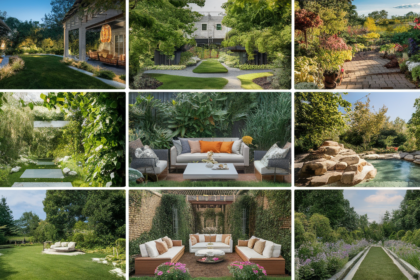Hey there, fellow garden enthusiasts! It’s that time of year again when the air gets crisp, leaves start to turn, and our summer gardens begin to look a little… well, sad. But fear not! I’m here to share my hard-won wisdom on how to breathe new life into your outdoor space with some gorgeous fall plants. Trust me, I’ve made every mistake in the book when it comes to autumn gardening, but those failures have led me to discover some truly stunning options that’ll make your neighbors green with envy.

Let’s dive into why fall planting is so awesome before we get to the good stuff. First off, cooler temperatures mean less stress on new plants, giving them a chance to establish strong roots before winter hits. Plus, you’ll save a ton on watering since Mother Nature tends to pitch in more during this season. And let’s not forget the amazing color palette autumn brings – rich reds, warm oranges, and deep purples that’ll make your garden pop!
Now, I know what you’re thinking – “But what about frost? Won’t it kill everything?” I used to worry about that too, until I learned which plants can handle a little chill. In fact, some even thrive in cooler weather! So, without further ado, let’s explore 15 stunning fall plants that’ll revive your garden and keep it looking fabulous well into the cooler months.
1. Chrysanthemums (Mums)

Ah, mums – the quintessential fall flower. These beauties come in a rainbow of colors and are tough as nails. I remember the first time I planted mums; I went a little overboard and turned my front yard into a veritable mum explosion. My neighbors probably thought I was running some kind of chrysanthemum cult, but hey, live and learn!
Mums are perfect for adding instant color to your garden. They’re like nature’s fireworks, bursting with vibrant blooms in shades of yellow, orange, red, purple, and white. Plus, they’re super low-maintenance, which is great for lazy gardeners like me.
Pro tip: Look for hardy varieties if you want your mums to come back year after year. And don’t forget to pinch them back in early summer to encourage bushier growth and more blooms come fall.
2. Asters

Next up, we’ve got asters – the unsung heroes of the fall garden. These daisy-like flowers are absolute pollinator magnets. I swear, sometimes my aster patch looks like a butterfly rave!
Asters come in shades of purple, pink, and white, and they bloom from late summer all the way through fall. They’re perfect for adding height to your garden and look stunning when planted in masses.
One year, I made the mistake of planting asters too close together, thinking they’d stay small. Boy, was I wrong! They grew into a tangled mess that looked like it was trying to eat my garden shed. Lesson learned: give these babies some space to spread out.
3. Pansies

Pansies are the tough guys of the flower world, don’t let their delicate looks fool you. These little troopers can handle frost like champs and will keep blooming well into winter in milder climates.
I love pansies for their cheerful “faces” and the wide range of colors they come in. They’re perfect for adding a pop of color to containers or as a border along walkways. Plus, they’re edible! Throw some pansy petals on a salad, and suddenly you’re a fancy chef.
Word to the wise: keep an eye out for slugs. Those slimy jerks love to munch on pansies. I once woke up to find half my pansy patch decimated overnight. It looked like a tiny, flowery crime scene.
4. Ornamental Kale and Cabbage

Okay, I know what you’re thinking – “Cabbage? In my flower garden?” Trust me on this one. Ornamental kale and cabbage are like the supermodels of the vegetable world. They’re gorgeous, colorful, and they thrive in cool weather.
These stunners come in shades of purple, pink, and white, with leaves that get more vibrant as temperatures drop. They’re perfect for adding texture and interest to your fall garden.
I’ll never forget the time I planted a bunch of ornamental kale, thinking I’d have a beautiful, edible garden. Turns out, ornamental varieties aren’t exactly tasty. My attempt at a kale smoothie was… less than successful. Stick to admiring these beauties with your eyes, not your taste buds.
5. Sedum ‘Autumn Joy’

Sedum ‘Autumn Joy’ is like the gift that keeps on giving. This perennial starts the season with green broccoli-like buds, then blooms into beautiful pink flowers that darken to a deep red as fall progresses.
What I love most about ‘Autumn Joy’ is its versatility. It looks great in rock gardens, borders, or even as a standalone specimen. Plus, it’s a favorite of butterflies and bees, so you’ll be doing your part for the pollinators.
Fun fact: I once used dried Sedum ‘Autumn Joy’ flowers in a fall wreath. It looked amazing, but I may have gone a bit overboard with the hot glue. Let’s just say that wreath is now a permanent fixture on my front door.
6. Russian Sage

Russian sage is the plant for those of us who tend to forget about watering (guilty as charged). This drought-tolerant perennial is perfect for adding a soft, airy texture to your fall garden.
With its silvery-gray foliage and lavender-blue flowers, Russian sage provides a beautiful contrast to the typical fall colors. It’s also deer-resistant, which is a huge plus if you live in an area where those four-legged garden destroyers roam free.
I once planted Russian sage along my driveway, thinking it would stay neat and tidy. Fast forward a few years, and it had turned into a lavender-scented jungle. Lesson learned: this plant needs room to spread, so plan accordingly!
7. Helenium

Helenium, also known as sneezeweed (don’t worry, it doesn’t actually make you sneeze), is a fantastic addition to any fall garden. With daisy-like flowers in shades of yellow, orange, and red, these plants look like they’re bringing the sunset right into your backyard.
These native North American plants are great for attracting butterflies and are deer-resistant. They bloom from late summer through fall, providing a long-lasting show of color.
I’ll admit, I was a bit skeptical about planting something called “sneezeweed” in my garden. But after seeing them in bloom, I was sold. Now I can’t imagine my fall garden without them.
8. Japanese Anemone

Japanese anemones are the epitome of elegance in the fall garden. With their delicate, windflower-like blooms in shades of pink and white, they add a touch of grace to any landscape.
These perennials bloom from late summer through fall and can reach heights of up to 4 feet. They’re perfect for adding vertical interest to the back of a border or as a focal point in a partially shaded area.
Word of caution: Japanese anemones can be a bit enthusiastic in their spreading. I once planted a few in my side yard, and within a couple of years, they had staged a full-scale invasion of my lawn. They’re beautiful, but keep an eye on them!
9. Toad Lily

If you’re looking for something a bit more exotic for your fall garden, look no further than the toad lily. These unique flowers have spotted petals that really do resemble a toad’s skin (in the most beautiful way possible, of course).
Toad lilies bloom in late summer and fall, preferring partial to full shade. They’re perfect for brightening up those darker corners of your garden where other fall flowers might struggle.
I remember the first time I saw a toad lily in bloom. I was convinced it was some kind of rare orchid that had magically appeared in my neighbor’s garden. Turns out, they’re not that hard to grow – just give them some shade and moist soil, and they’ll reward you with their quirky blooms.
10. Goldenrod

Goldenrod gets a bad rap because people often confuse it with ragweed (the real allergy culprit). But this native plant is actually a fantastic addition to any fall garden.
With its bright yellow plumes, goldenrod adds a sunny splash of color to the autumn landscape. It’s also a crucial late-season food source for pollinators, so you’ll be doing your part for the environment too.
I used to be one of those people who thought goldenrod was just a weed. But after learning about its benefits and seeing it in a well-designed garden, I’m a convert. Now I let it grow freely in my wildflower meadow, and the bees couldn’t be happier.
11. Coneflower (Echinacea)

Coneflowers are the workhorses of the fall garden. These native perennials bloom from summer into fall, providing long-lasting color and attracting butterflies and birds.
While purple coneflowers are the most common, you can now find varieties in a range of colors, including white, yellow, orange, and even green. They’re drought-tolerant once established and make great cut flowers.
Pro tip: Leave some coneflower seed heads standing through winter. They provide food for birds and add interest to the winter landscape. Plus, watching goldfinches acrobatically balance on the seed heads is free entertainment during those cold months!
12. Black-Eyed Susan (Rudbeckia)

Black-eyed Susans are like sunshine on a stem. These cheery yellow flowers with dark centers bloom from summer into fall, providing a bright spot in the garden as other plants start to fade.
These native plants are incredibly easy to grow and are drought-tolerant once established. They look great in mass plantings or mixed with other fall bloomers like asters and goldenrod.
I once decided to collect seeds from my black-eyed Susans to spread around the garden. Let’s just say I got a little overzealous, and the next spring, it looked like I was trying to create a mini prairie in my backyard. They self-seed readily, so be prepared for volunteers!
13. Beautyberry

Beautyberry is all about the, well, berries. This deciduous shrub produces clusters of vibrant purple berries in the fall that look almost too perfect to be real.
While the spring flowers are insignificant, the fall berry display is truly spectacular. The bright purple berries persist well into winter, providing food for birds and visual interest in the garden long after other plants have gone dormant.
Fun fact: I once tried making beautyberry jelly. It looked amazing (that color!), but the taste was… interesting. Let’s just say I’ll leave the berries for the birds from now on.
14. Winterberry Holly

Winterberry holly is the plant that keeps on giving through fall and winter. This native shrub loses its leaves in the fall, but that just serves to highlight its spectacular display of bright red berries.
Unlike other hollies, winterberry prefers moist soil and can even tolerate wet areas. It’s perfect for rain gardens or those spots in your yard that never seem to dry out.
One thing to note: Winterberry is dioecious, meaning you need both male and female plants to get berries. I learned this the hard way after planting a lone winterberry and wondering why it never produced any fruit. Now I know – it takes two to tango in the winterberry world!
15. Heuchera (Coral Bells)

Last but certainly not least, we have Heuchera, also known as coral bells. While these perennials are grown primarily for their foliage, they’re a fantastic addition to the fall garden.
Heucheras come in a stunning array of colors, from deep purples and reds to lime greens and silvers. They retain their foliage through fall and even into winter in milder climates, providing color and texture when other plants have gone dormant.
I love using Heucheras in container plantings. They pair beautifully with fall bloomers like mums and pansies, and their colorful leaves continue to look great even after the flowers have faded.
So there you have it, folks – 15 stunning fall plants to revive your garden. From the classic mums to the unique toad lilies, there’s something here for every garden style and growing condition.
Remember, fall planting isn’t just about adding color to your garden for a few months. Many of these plants will come back year after year, getting bigger and better with time. It’s like investing in your future garden – plant now, and reap the rewards for years to come.
As you plan your fall garden, don’t be afraid to mix things up. Combine different textures, heights, and colors to create a garden that’s uniquely yours. And most importantly, have fun with it! Gardening should be enjoyable, not stressful.
I hope this list has inspired you to get out there and give your garden a fall makeover. Trust me, there’s nothing quite like sipping a pumpkin spice latte (because, let’s face it, it’s fall) while admiring your handiwork on a crisp autumn day.
Happy planting, and may your fall garden be the envy of the neighborhood! Just remember, if you end up with a garden full of mums like I did that one year, you can always tell people you’re going for a “themed” look. Works every time!





